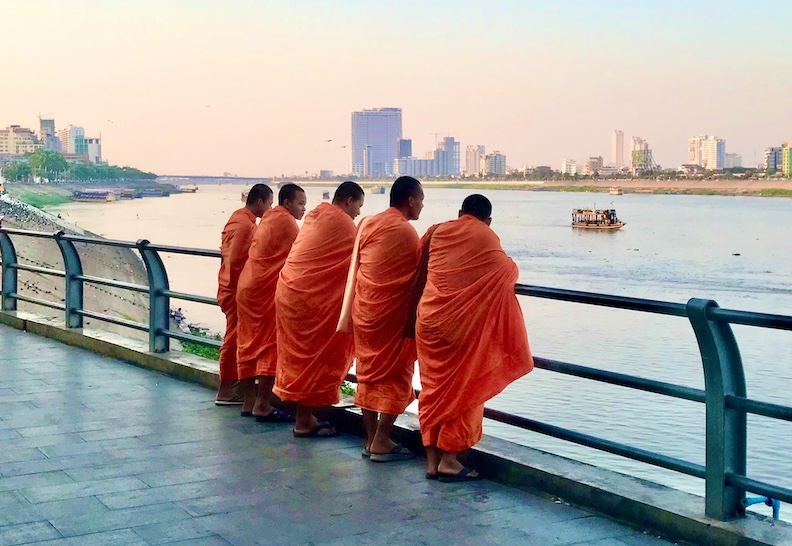
Young monks on a twilight stroll pause to ponder passing boats on the Tonlé Sap River in central Phnom Penh. The stream flows 110 miles from a great lake to join the Mekong just downstream of here. Photo by John Gottberg Anderson
By John Gottberg Anderson
The tuk-tuk driver reclined on a padded seat in the back of his motorized transport, neither a surrey nor a golf cart but something in between. “Hey, bong, nice to see you today,” he said as I passed, using the catch-all greeting so frequently used in this Southeast Asian nation. “Where are you going?”
I had no destination so I paused to chat. Like many of the minimum-wage drivers in Phnom Penh, Cambodia’s bustling capital city, he lived off the hustle, but relaxing in the tropical heat and humidity often takes precedence. So we spoke in platitudes and simple sentences for a few moments until I offered to climb aboard the motorbike that pulled his vehicle and go for a drive.
“Okay, no problem!” he happily exclaimed. “Where do you want to go?” I asked. “Up to you!” he replied.
So, I straddled the bike and turned the key. Nothing happened I looked everywhere for an ignition switch. “I give up,” I said to my new friend. “How do I start?”
“I don’t know,” he replied. “It’s not my tuk-tuk!”
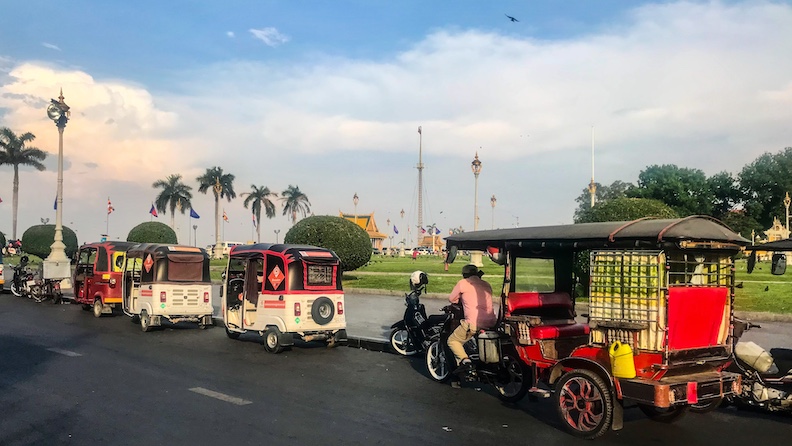
Open-sided tuk-tuks and motorized golf carts wait for fares outside Royal Palace Park. It costs just US$2 to travel to most destinations within Phnom Penh’s urban core. Photo by John Gottberg Anderson
An easygoing people
A sense of humor and an ability to let go of cultural judgments are essential tools for any traveler. In Cambodia, these come effortlessly. The easygoing people of this Southeast Asian nation are even more welcoming than citizens of other nearby countries — which is slightly remarkable, given the hell they suffered a half century ago.
Tourists come to Cambodia to wander the medieval ruins of Angkor, once the greatest city for thousands of miles in all directions. They may relax in the resorts and spas of Siem Reap or at sun-spanked islands like Koh Rong in the Gulf of Thailand near Sihanoukville. Coming or going, or both, they inevitably spend a few days in Phnom Penh.
By Asian standards, Phnom Penh is not a particularly large city. With 2.3 million inhabitants, it pales in comparison with Bangkok, the flourishing hub of Thailand, or Ho Chi Minh City (Saigon) in neighboring Vietnam. But it is the lone metropolis of Cambodia, an ancient land also known as Kampuchea, only just now emerging on the world stage as a player in the future of Southeast Asia.
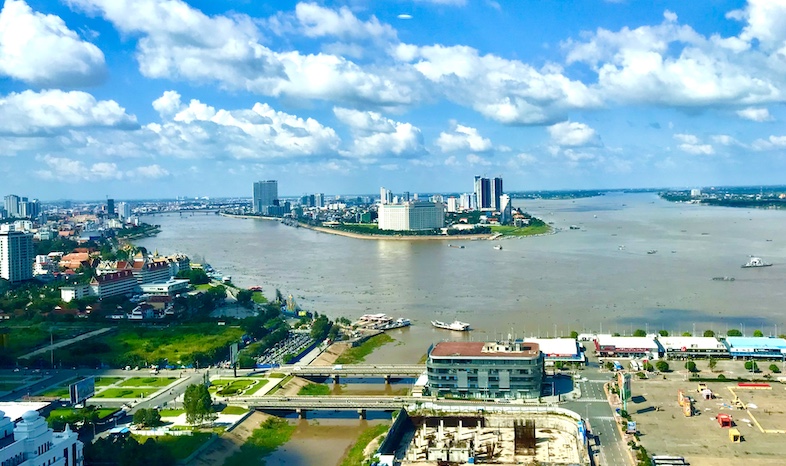
The Mekong River, at right, is joined by the Tonlé Sap, a major tributary, in the heart of Phnom Penh. This view is from an office tower on Koh Pich (Diamond Island), a reclaimed sandbar at the mouth of the Bassac River. Photo by John Gottberg Anderson
Located where the Tonlé Sap and Bassac rivers meet the mighty Mekong, the city has been here for 650 years. The Cambodian capital since 1866, its central tourist area is Daun Penh, along the Tonlé Sap’s west bank. Here is the Royal Palace, home to King Norodom Sihamoni and the bejeweled Silver Pagoda, a glittering and many-spired tribute to the ancient glory of the Khmer Empire. Sihamoni, now 71, spent half his life in Europe, mainly as a student in Prague and a professor of classical dance in Paris, where he was Cambodia’s UNESCO representative when he wasn’t wearing ballet slippers. He became king in 2004 when his fabled father, Norodom Sihanouk, stepped down.
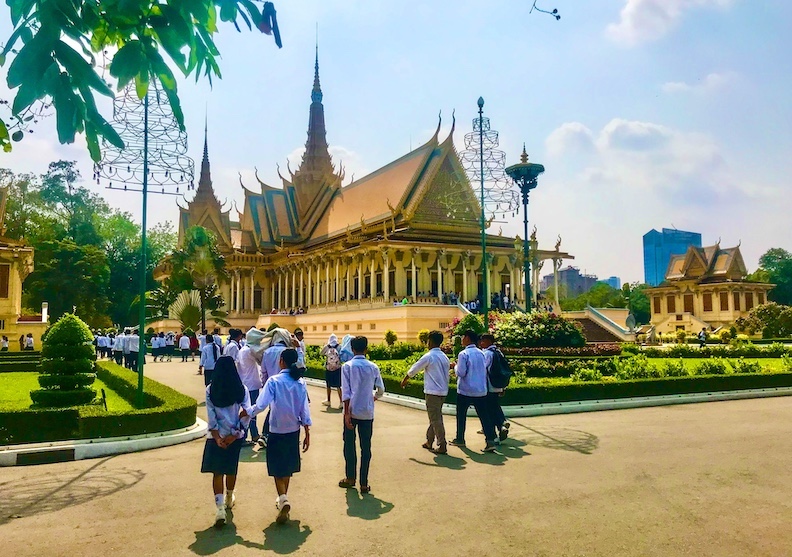
High-school students arrive to tour Cambodia’s Royal Palace, built in 1866 as the residence of the kingdom’s royal family. The compound includes a treasure house and the bejeweled Silver Pagoda, inspired by the glory of the ancient Khmer Empire. Photo by John Gottberg Anderson
The palace is next to the magnificent National Museum of Cambodia, whose collection includes 33 statues looted from Angkor by post-colonial treasure hunters and returned to Cambodia only in 2023. Wat Phnom, an intimate temple atop a low hill just north of the downtown area; was built in 1434 and three times restored, the last in 1926. Seven-headed nagas, great cobras of Buddhist legend, guard the entrances as if to strike at unholy intruders. A high fence built around the temple’s perimeter helps to preserve its sense of antiquity, for those who come for prayers, meditation or offerings.
The Buddha’s eyebrow
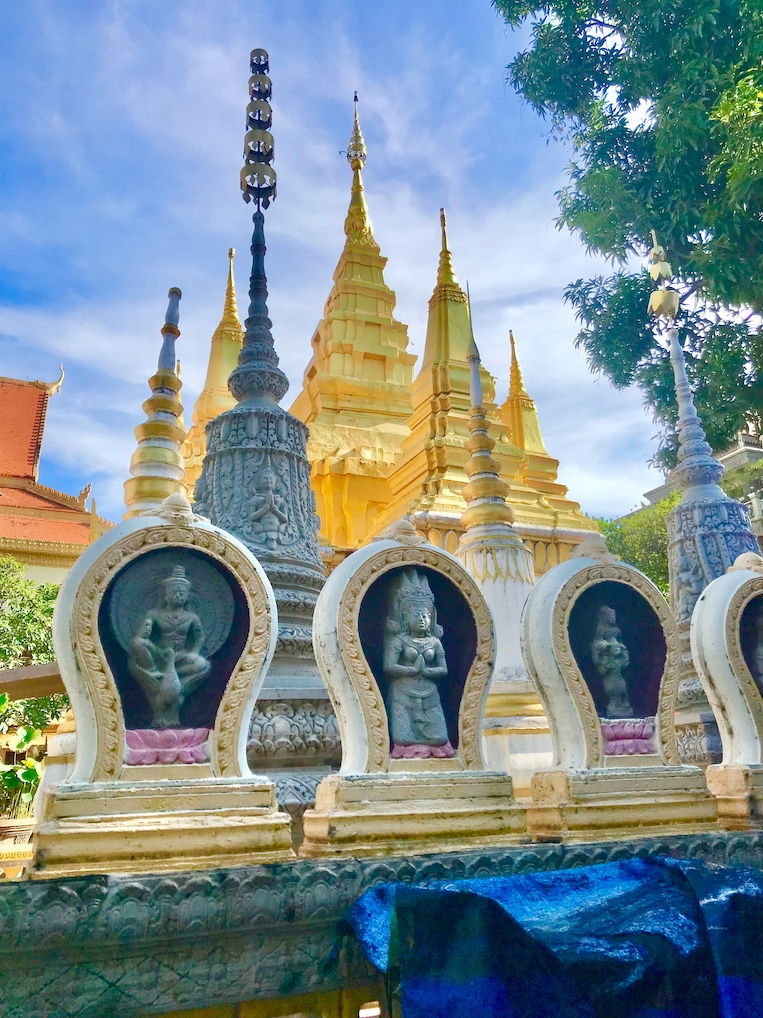
Images of bodhisattvas adorn the perimeter of a Phnom Penh pagoda courtyard, one of nearly 4,700 in Cambodia. Photo by John Gottberg Anderson
Wat Ounalom is another temple with a long history. The “Temple of the Eyebrow Hair” was first built beside the Tonlé Sap in the 15th Century to enshrine a sacred relic from the brow of the historical Buddha. The modern temple, as the center point of Cambodian Buddhism, is a replica of the original. When erected in 1952 as a complex of 44 buildings, it included a vast library and lodging for more than 500 monks. But in the late 1970s the Khmer Rouge devastated Wat Ounalom, killing its patriarch and many other monks in the rebels’ psychopathic purge of religion, education and urban society.
A quarter of the population of Cambodia died during this 45-month reign of terror, during which the Communist “red Cambodians” set out to restructure the country as an agrarian society in the style of Mao Tse-tung’s China. Cities were evacuated and an unprepared population was sent to work on collective farms. Factories were abandoned, banks shuttered, and religion viciously suppressed. Those who raised their voices were imprisoned and executed.
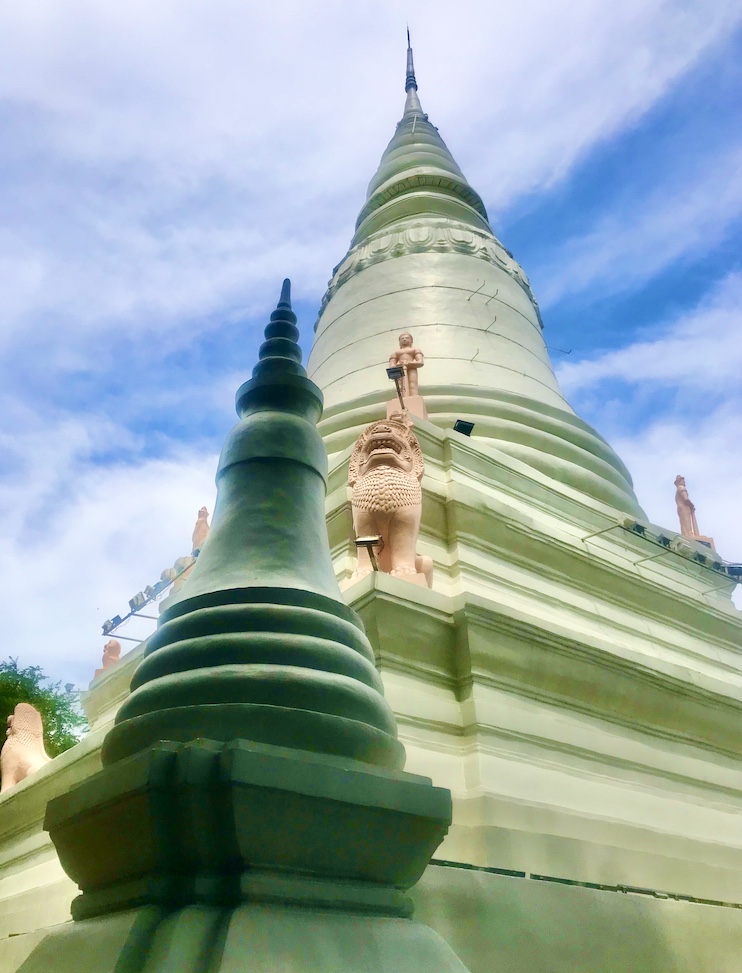
A modern stupa rises high above Wat Ounalom, built in the 15th century to enshrine a sacred eyebrow hair of the Buddha. It was rebuilt after devastation at the hands of the Khmer Rouge in the late 1970s. Photo by John Gottberg Anderson
Phnom Penh was all but deserted when the army of Vietnam, incited by Khmer incursions into the Mekong Delta, overthrew the Reds in early 1979. Loans from the Asian Development Bank and the World Bank helped the city reconstruct, along with investment from such countries as France, Australia, Japan and (more recently) China. Monks solicited donations to repair Wat Ounalom monastery and pagoda, today crowned by a monumental stupa.
There is a notably higher level of direct foreign investment, yet less obsession with personal wealth, than in neighboring Vietnam. Resident foreigners, including many French, live throughout Phnom Penh, especially in the Russian Market and Boeung Keng Kang (BKK) precincts, where barang are often full owners of thriving businesses. Many former French colonial manses, transformed into government buildings in the ‘50s, are now boutique hotels. In tourist-friendly alleys such as Bassac Street, historic shophouses are now small restaurants, bars and inns. And Phnom Penh also welcomes a quirky element. Visitors to the BattBong cocktail lounge in Langka Lane, for instance, enter the stylish establishment through a door in a Coca-Cola machine. There’s no other identifying sign. It may be the ultimate speakeasy.
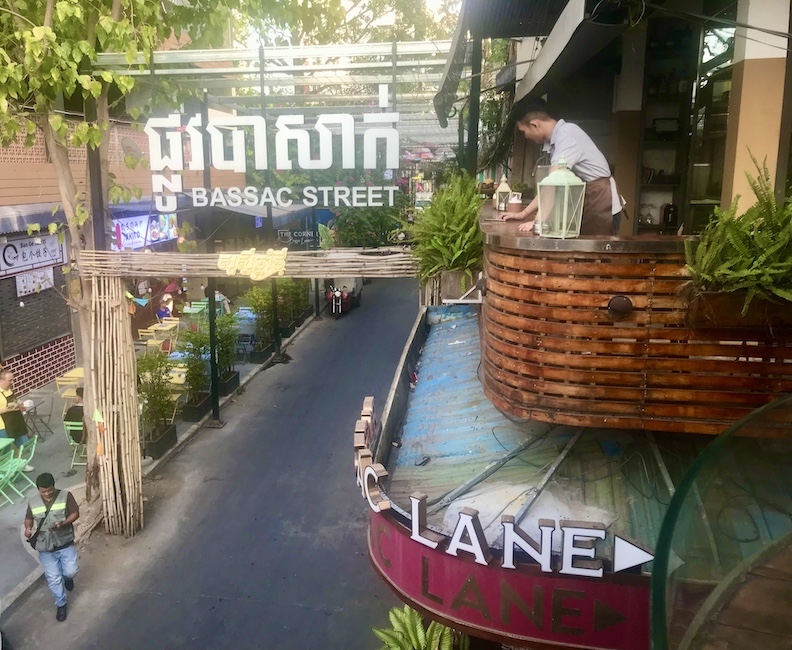
In the tourist-friendly alleys of Bassac Street and adjacent Bassac Lane, quirky restaurants, bars and boutique hotels welcome tourists and residents. Photo by John Gottberg Anderson
Women are stepping up as national leaders. As governor of the National Bank of Cambodia, Dr. Chea Serea champions “financial literacy” as a key factor in reducing poverty. Caribbean-born environmental consultant Cécile Dahomé promotes climate-smart agricultural practices and collaboration between private and governmental sectors. Laura Mam, an American-born Khmer music producer, set out to focus world attention on Cambodian beats and boosted hip-hop artist VannDa (“Time to Rise”) to superstar status.
Sisowath Quay
No place in modern Phnom Penh is more popular for strolling than Sisowath Quay, a long and tidy esplanade known simply as Riverside. It follows the bank of the Tonlé Sap river in the final stretch of its 110-mile (180 km) run from the inland sea (also Tonlé Sap) that is Southeast Asia’s largest lake. From the city’s ubiquitous rooftop “sky bars,” one can easily see the point at which the silty-brown river converges with the Mekong, a brighter bluish gray in color. In the May-to-November wet season, so much water flows down the Mekong that it pushes water up the Tonlé Sap to the lake, reversing its flow and creating “floating villages.”
Before beginning a Riverside promenade, pedestrians often gather in Royal Palace Park, where resident pigeons cluster like cicadas. Here, at the Moonlight Pavilion, the bachelor king with a monastic lifestyle occasionally greets well-wishers like a Far Eastern pope. The monarch is active as a cultural advocate, especially in arts and traditional Buddhism. His governmental role is largely ceremonial.
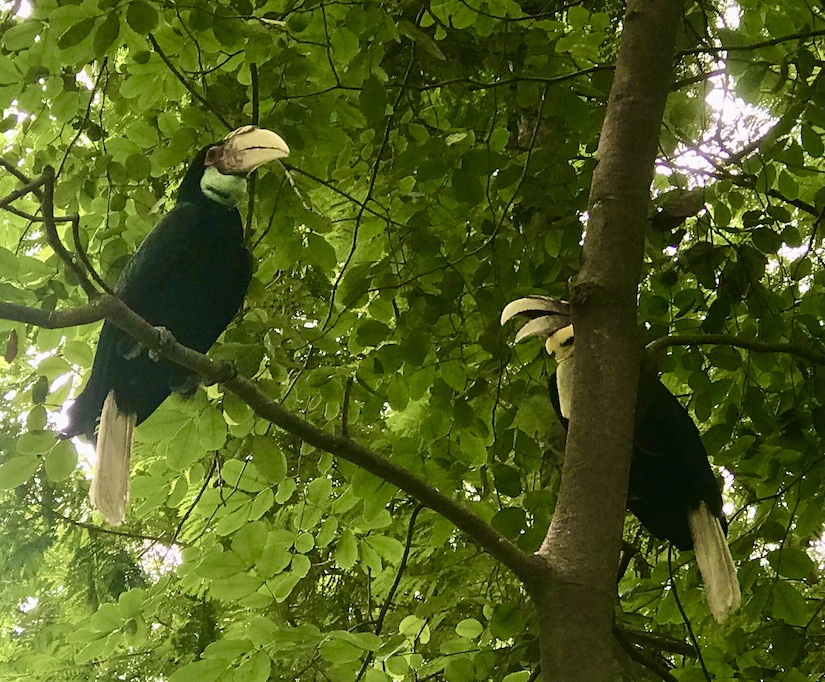
Ungainly looking great hornbills share the shade of a lush tree on the grounds of Wat Phnom. With bills that appear larger than their heads, they are omnivorous but prefer fruit to meat. Photo by John Gottberg Anderson
Vendors sell popcorn kernels to feed the plump squabs, which somehow still escape the grasping arms of scrambling children. Mobile kitchens hawk a variety of six- and eight-legged critters — insects, grubs and tarantulas — fried in oil, and charge tourists a dollar for every photograph they take without tasting. There’s good money to be made from the skittish out-of-towners, who may be fascinated by the concept of biting into a creepy-crawly but repulsed by the idea of actually doing so. Ungainly looking great hornbills, endangered birds whose yellow bills appear larger than their heads, scavenge rotting fruit offerings from small shrines beneath the eaves of buildings. Clearly visible to the north, a Japanese-built bridge crosses to Chroy Changvar, a satellite city wedged between the Tonlé Sap and Mekong, where ferries operate to a quaint silk-weaving enclave on Koh Dach island.
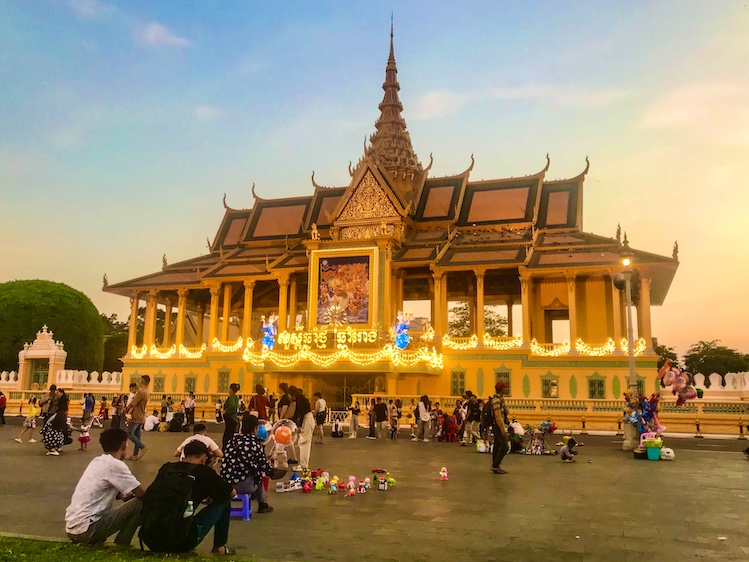
As the sun goes down, bright lights illuminate the Moonlight Pavilion, where King Norodom Sihamoni, 71, sometimes hails well-wishers. Formerly a dance professor and Cambodia’s UNESCO representative in Paris, he became king in 2004. Photo by John Gottberg Anderson
Well-wishers deliver pink and white lotus blossoms to Taoist protector gods in a pair of small sanctuaries overlooking the water. Even Buddhist monks beseech ancestral spirits at the Preah Ang Dorngkeu shrine, offering flowers and lighting incense sticks before continuing a stroll beneath shady acacia trees. Industrious businesswomen urge passers-by to stop and enjoy fruits and vegetables, meat sticks, kuy teav soup, snails, embryonic duck eggs, young coconuts, peanuts or ice cream.
Phnom Penh’s famous November water festival, Bon Om Touk, coincides with the return of the river’s natural flow. There’s no more exciting time on Riverside, as teams from every Cambodian province gather to compete in three days of colorful longboat races on the Tonlé Sap. During the Khmer new year, Choul Chnam Thmey, coinciding with Thailand’s mid-April Songkran fest, trucks full of boisterous young people cruise Sisowath Quay and other avenues, throwing water and baby powder upon the less-than-observant.
Night moves
From the Royal Palace to the animated Night Market, the east-facing side of Sisowath Quay features 10 blocks of shoulder-to-shoulder small hotels, coffee and tea shops, convenience stores, massage parlors, banks and restaurants — Indian, French, Japanese, Mexican, Thai, Korean and American burger joints. Casual Khmer eateries dominate, presenting popular local dishes like fish amok, a coconut-milk curry steamed in banana leaves, and stir-fried cubes of beef lok lak, served with rice and topped with a fried egg. Cheap Angkor and Krud draught beer (75 cents a mug) flows easily at the River Crown, River Quay, River Bistro and Riverside Lounge. A half-dozen side streets are home to Phnom Penh’s infamous hostess bars, where clubs like the Pussycat, Honey Pot, Step Wife and Intoxica encourage male visitors to spend too much money on overpriced “lady drinks” as seductive young women sprawl across their laps and whisper in their ears, perhaps negotiating additional favors.
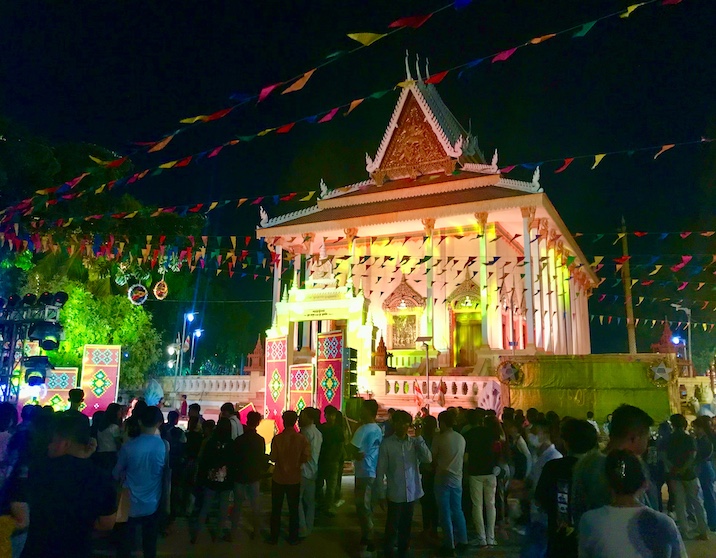
Pagodas across Cambodia celebrate Choul Chnam Thmey, the Khmer new year, in mid-April. Coinciding with Songkran in Thailand, it is highlighted by throwing water on nearly everyone. Photo by John Gottberg Anderson
In the early evening hours, as day’s heat melts into habitability with the help of light breezes, riverside ramblers move aside to let bicyclists and rollerbladers pass. On one wide stretch of pavement, synchronized dancers practice their steps at dusk beside an alfresco gallery of exercise equipment. Unchaperoned toddlers, many of them unclothed, stare at older children who walk along the edge of a steep berm with fishing poles in hand. A bright green neon sign across the river urges tipplers to enjoy Carlsberg beer, even though the Danish brew is rarely seen here.
As darkness falls, a fleet of boats strung with colored lights weigh anchor to view Phnom Penh’s brilliance from the water. Sixty-minute sunset cruises cost as little as US$8; an increasingly elaborate range of dinner cruises run as much as US$75. From the normally placid river, the lights of the Royal Palace offer a true spectacle, its soaring rooflines and stately spires brightly illuminated for the Cambodian nights. Cruises may continue south past the palace as far as the Bassac River where it sweeps around Koh Pich (Diamond Island). Still under development, this reclaimed sandbar now spawns 30-story, Chinese-built high-rise business and residential towers, home to many international corporate offices.
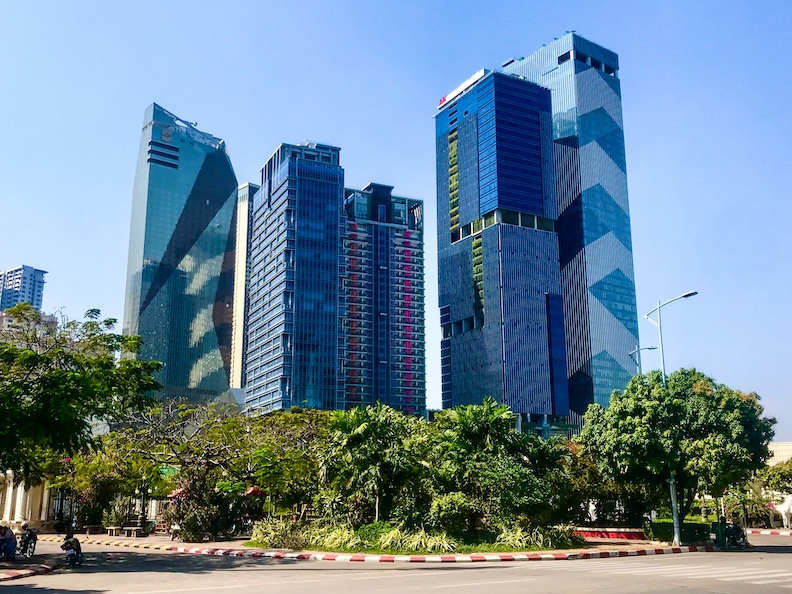
Still under development, Koh Pich (Diamond Island) is a reclaimed sandbar that now spawns 30-story, Chinese-built high-rise business and residential towers. Photo by John Gottberg Anderson
Recipe for recovery
After having swapped the nation’s heritage for an era of disaster, the Khmer Rouge tragedy is the “unseen elephant” in any discussion of Cambodia’s past, present and future. But the citizens of this rapidly modernizing city have largely learned to move on, even in the knowledge that the vast majority of their leaders — educators, doctors, business executives and so many others (journalists, too) — were eliminated in the savagery that took almost 2 million lives. That’s why Cambodians have looked beyond their own borders in their recovery.
“Cambodia is a very exciting place to be right now,” University of Puthisastra president Ian Findlay told me. “After 20 years of sleeping with a stable government, we now have a new focus, a new government. Cambodia needs to be seen as much more than genocide and Angkor Wat. But it’s a major challenge. Cambodia lost an entire generation of mentors. Leaders between 50 and 70 don’t exist.”
Chinese investment, which crested in 2019 but came to a near-standstill during the Covid pandemic, has re-emerged in a big way — especially regarding transportation infrastructure. In 2023 alone, 45 percent of direct foreign investment in Cambodia came from Chinese enterprises, more than US$3 billion spanning sectors from garment manufacturing to agriculture. China’s touted Belt and Road initiative, which Cambodia has embraced since 2016, is responsible for new international airports in Siem Reap (opened in 2024) and suburban Phnom Penh (scheduled in 2025), a US$2 billion expressway and numerous other projects, including the controversial Funan-Techo canal that will divert river traffic from the lower Mekong Delta through Cambodia to the Gulf of Thailand. Vietnam claims the canal will wreak havoc upon the fragile Mekong ecosystem. Cambodia insists it is necessary to reduce transportation costs and to support agriculture and port development, mainly in the coastal city of Sihanoukville.
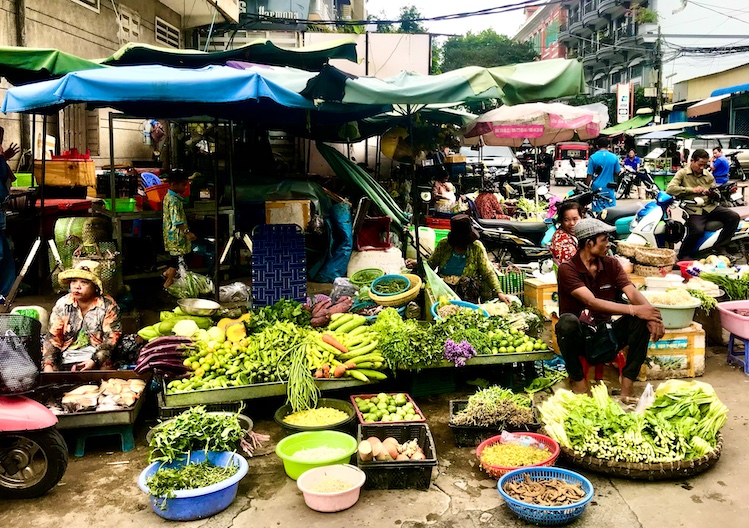
Urban vegetable markets, a throwback to the traditional Cambodian lifestyle, welcome visitors to busy city streets from early morning to early evening. Photo by John Gottberg Anderson
Rarely mentioned in the Cambodian argument is the small but thorny Chinese presence near Sihanoukville at the Ream Naval Base. The Cambodian government insists that two warships docked here since late 2023 are only on a temporary visit for joint military drills. Chinese began investing heavily in casino resorts in Sihanoukville, until then a sleepy beach town, around 2010. Then the real-estate market collapsed, and in 2023, according to government figures, Sihanoukville had more than 350 unfinished buildings and an additional 170 completed but sitting idle. There’s not a lot for visitors to see. Today the city is best known as the port for boats that ferry tourists to offshore resort islands such as Koh Rong and Song Saa.
The Killing Fields
Morning light bathes Daun Penh’s busy urban vegetable and meat markets as tuk-tuk drivers jostle in the blocks near the Royal Palace to take customers on sightseeing trips — perhaps into the countryside to historic sites like Oudong, the capital before Phnom Penh, or Phnom Chisor, an ancient Hindu hilltop site built by an Angkorian king. But the most popular excursions are to the “Killing Fields.” These are not for the faint of heart, but they are essential for understanding the Cambodian psyche.
Having declared independence from France in 1953, Cambodia was a sacrificial lamb during the Vietnam War. In 1969, US bombing raids targeted North Vietnamese military bases inside Cambodia. In five years of subsequent civil war, North Vietnam overran large areas of eastern Cambodia, which it gave to the Khmer Rouge. Two weeks before North Vietnam’s conquest of Saigon, in April 1975, Cambodia’s democratic government surrendered to the Communists.
The era will not soon be forgotten. In Phnom Penh, two somber sites are constant reminders. More than 18,000 prisoners passed through the gates of Security Prison 21 (“S-21”), now known as the Tuol Sleng Genocide Museum. Only seven survived. Previously a public high school in the BKK district, S-21 was one of 196 prisons the Khmer Rouge operated across Cambodia. Suspects were tortured and interrogated until their “confessions” implicated others. Separated from their parents, children were often manipulated to invent stories and squeal on their family members. Today, graphic photographs illustrate unspeakable horror in classrooms converted to cells. The ground level of Building C is wrapped in barbed wire, reportedly a suicide-prevention device. But if the prisoners were going to be executed in any event, why try to stop them?
When torture and interrogation at S-21 had run their course, the prisoners were blindfolded, loaded into trucks, and taken to the Killing Fields for execution. At the Choeung Ek Genocidal Center, 10 miles (16 km) south of the Royal Palace, mass graves and bones leave nothing to the imagination. Audio headphones today guide visitors through the terror. As many as 300 citizens a day were executed, their bodies tossed into pits. To save bullets, they were often beaten to death with pickaxes, hatchets or shovels. Victims who awaited their doom were shackled and held overnight in a pitch-black building. Chemicals such as DDT were stored nearby; immediately upon execution, these substances were spread over dead bodies to mask the stench. In some places, bone fragments still find their way through the soft soil to break ground.
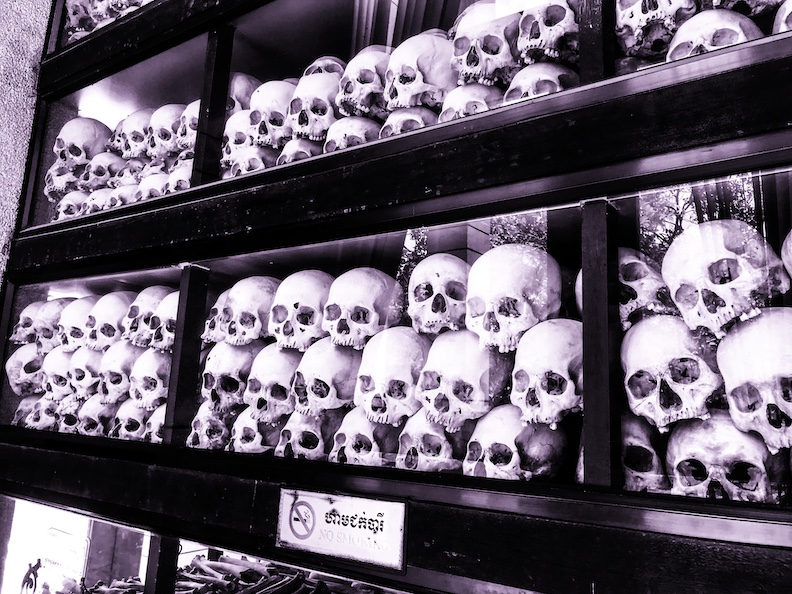
Thousands of human skulls are stacked in the memorial pagoda at the heart of the Choeung Ek Genocidal Center, better known as the Killing Fields. A quarter of all Cambodians died at the hands of the Khmer Rouge between 1975 and 1979. Photo by John Gottberg Anderson
The horror culminates at the memorial pagoda at the heart of the complex. It is a repository for thousands of human skulls, their vacant stares stacked in a macabre tower of terror. Many have been categorized by age and gender. Visitors with shoes and hats removed may reverently squeeze around all four sides of the glass-encased cenotaph.
Free and fractured
The 1980s brought no peace to a fractured Cambodia. Not until the early 1990s did the United Nations step in to enforce a ceasefire between feuding factions. “Free and fair” elections in 1993 resulted in a coalition government between the two leading parties, but the runner-up Cambodian People’s Party (CPP) took full control in a 1997 coup orchestrated by its leader, Hun Sen, who had served as prime minister since 1985.
Now 71 years old, Hun Sen grips power like a bulldog with a bone. He’s no longer prime minister — after 38 years at the helm, he stepped down last August, having chosen his son, Hun Manet, to replace him — but he brooks no dissent, having solidified one-party rule and curbed a free press as tightly as neighboring Vietnam. Nepotism is alive and well.
Corruption extends through the entire bureaucracy. US Ambassador Cindy Dyer, a prominent watchdog of cyber-trafficking in Southeast Asia, told me her questions to Cambodian officials are “more often than not greeted with denial or, at the very least, deflection.”
“When we brought up concerns about corruption and complicity, we didn’t get much of a response,” she said. “High-level government officials may be in the front.”
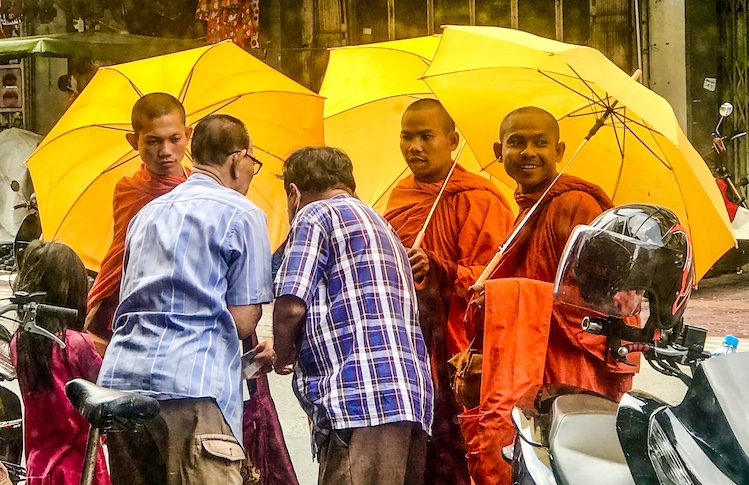
As umbrellas provide shade from the sun, a trio of monks accept daily alms for prayers delivered to downtown merchants. Traditional Theravada Buddhism continues to be practiced throughout Cambodia. Photo by John Gottberg Anderson
The biggest legacy of the United Nations Transitional Authority in Cambodia (UNTAC) may be the ubiquity of US dollars in the local economy. The Cambodian riel was all but worthless when UN peacekeeping forces were active. Employees, both international and Cambodian, were paid in dollars. Even today, ATMs dispense $100 bills like lottery tickets. And dollars remain the preferred medium for major purchases. The new SOSORO Museum, owned by the National Bank of Cambodia, tells a fascinating story about the history of currency and exchange in this country, dating from pre-Angkor.
Meanwhile, the average citizen of Phnom Penh turns a blind eye to government chicanery, plowing ahead in the belief that — although their opportunities are determined by a fortunate few — they have food and drink and smiles on their faces. They can feed their parents and their children, they have extended families who care about them, and they live in a country with a glorious past and a hopeful future.
Today a new legion of monks, young and old, carry on the ancient traditions of Cambodian Buddhism. Each morning, upon completing their daybreak litanies, they spread through Phnom Penh from their monastery bunks, accepting donations in alms bowls for the prayers they utter at shops and restaurants It’s even not unusual to spot their saffron robes disembarking from tuk-tuks, whose drivers are perhaps rewarded with karmic merit for door-to-door service to Ounalom or other temples.
You will probably not see, however, a monk driving a tuk-tuk. That might be crossing a line between sacred and profane, a threshold that only the divine (or a government official) can see.![]()
Veteran journalist John Gottberg Anderson now lives in Cambodia after 3½ years in Vietnam. He is a former editor for The Los Angeles Times and the Southeast Asia Globe. His previous East-West News Service stories focused on Vietnam’s feminine áo dài dresses and the Tet holiday.

